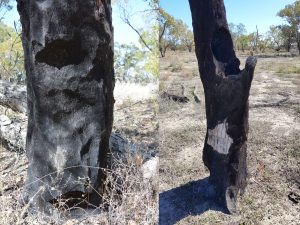It’s not climate change but people change that’s turning our National Parks & Nature Reserves into giant bonfires. Colonisation removed the old fire-stick farmers & the conservation movement removed the new conventional farmers/ graziers. Last week lightning lit up the Narran lakes nature reserve and 22,000 hectares was burnt before rain eventually put the fire out. Despite an Aboriginal co-management committee, NSW Parks & Wildlife have never put in firebreaks or back burnt the reserve in preparation for events such as this. The same dry electrical storm also caused fires on surrounding properties, but the farmers promptly extinguished these. Farmers have graders & dozers & water filled RFS trucks – The Narran lakes nature Reserve doesn’t even have decent maps! Water bombers days after a bushfire starts are no match for preparation & prompt responses…
Much of the Govt owned land in Australia is either unmanaged or badly managed. Unmanaged unstocked land builds up rank vegetation & mid-level layers of highly flammable bushes & scrub trees. Grass fires jump up into the trees via invasive native scrub and noxious weeds to become out of control forest fires. Pre-settlement this danger was dealt with by continual cool season burns and post-settlement livestock ate the grasses & emerging bushes & small trees. Unpalatable native scrub trees here such as budda & pine turned invasive in the wet years & spread out across any uncultivated country. Kangaroos and smaller native grazing animals do not eat long dry grass or scrub. Goats do but Parks & Wildlife management contract periodic helicopter shoots to remove them. No fire mitigation = No scartrees
There are plenty of individually burnt CMTs here – for a variety of reasons. Small fires were set at the base of hollow eucalypts to smoke out possums leaving burn scars still obvious centuries later.

Campfires were also set against leaning trunks to protect the ashes from the weather. The larger the group of travellers the more fire scars on tree trunks.

There are also sometimes scorch marks in the forks and crotches of trees where someone has rested their firestick – lol

Spot burns are also found as part of larger scars for unknown reasons. Some of these complicated convoluted trunk canvases would have meanings lost in time now.


Hollow trees are sometimes almost entirely burnt out as if the trunks were used as ovens.

The most interesting individual burns are what Allan & I called charcoal rub trees. Allan said charcoal was in important ingredient in many medicines and used regularly. All the good camping areas have one of these charcoal rub trees. Allan didn’t know why they preferred to use one tree to source charcoal or if it was special in some way.






Some of these burnt stumps have been fashioned into rings or perfect curves which we think may have had navigational significance. They should have national significance, but no one cares about the old ways now.


Not only do farmers in this region have to cope with the idiotic Govt. mindset of lock up and leave 000s of hectares of land to manage itself we also have to contend with the nut jobs in the mining industry wanting to turn the (GAB – Great Artesian Basin) aquifers into the world’s biggest soda stream. Glencore’s newest CCS (carbon capture and storage) plan would lead to 10,000-fold increase in the water acidity and jeopardise all livestock enterprises in southern Qld and Northern NSW not to mention the native fauna. 120 towns in the region that rely on the GAB would be treated to free sparkling water with dissolved arsenic & lead from the decreased PH dissolving underground rock. YAY. If Glencore thinks the GAB would make a handy receptacle for 110,000 tonnes of CO2 a year their execs would have about as much imagination as upper management in the NSW Dept. of Parks & Wildlife.
